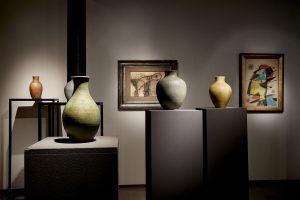2 results
“What I am looking for is a motionless movement, something that would be the equivalent of what is called the eloquence of silence.”
Biografia
Joan Miró (Barcelona, 1893 – Palma de Mallorca, 1983) is one of the most important Catalan artists of the XX century mainly associated with abstraction, who played with textures and materials in his works. In his oniric and fantasy-driven art, he affirms the aim to abandon the conventional methods of painting by adding three-dimensionality to his pieces, making collages, mobiles, and sculptures that he called "Poetic Objects."
He entered the Francesc Galí art school in 1912, where the master's anti-academic methods were decisive in the painter's work. At school he will meet different artists such as Josep Prats, Josep Francesc Ràfols, Enric Cristòfol Ricart or Josep Llorens Artigas. He will meet the art dealer Josep Dalmau who will introduce him to Francis Picabia and Maurice Reynal, artists who would greatly influence his work. In 1918 he held his first exhibition at the Dalmau galleries in Barcelona. In this first stage of his life, his work will have a lot of Cubist influence, as well as Fauvism.
However, from 1920 his work will begin to evolve into a more personal style, as he was already showing the public this particular dream world he ended up portraying. He will travel to Paris in 1921, and will exhibit at the Galerie La Licorne. During this period, he will interact with different personalities such as Jean Dubuffet, Ernest Hemingway, or Max Ernst, among others.
He will travel to the Netherlands, a trip that will be reflected in his work Dutch Interiors, and will hold an exhibition at the Berheim gallery, which marked his consecration as an artist. During the Spanish Civil War, he stayed in Paris, where, in 1937, he produced a large mural painting for the Pavilion of the Spanish Republic for the International Exhibition in Paris. In the forties, the Museum of Modern Art in New York will carry out a great retrospective of his work, and he also participated in different international exhibitions such as Le Surrealism in 1947, Exposition International du surréalisme, in Paris, organized by André Breton and Marcel Duchamp.
After that, he will remain in Barcelona, where he will focus on working on ceramics and later on large-scale iron sculpture. In the last years of his life, he was awarded many illustrious prizes, he received an honorary doctorate from Harvard University, and also the Gold Medal of Fine Arts from the Spanish State. In 1983, many international retrospectives were held on him to celebrate his ninetieth birthday, such as Joan Miró: A Ninetieth-Birthday Tribute, at the Museum of Modern Art in New York, or Joan Miró: the 1920s. Mutation of Reality, at the Fundación Joan Miro in Barcelona. He passed away in Palma de Mallorca that same year on December 23.


